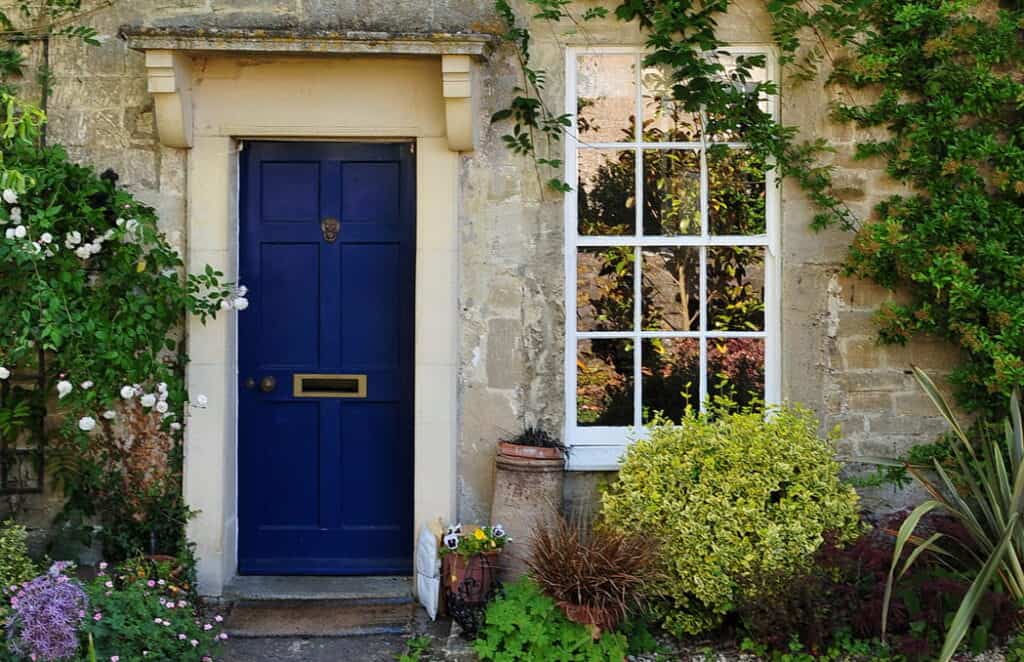If you’ve ever walked around an old English cottage, you might have noticed how low the doors and ceilings are.
Even people of average modern height will need to duck to get through old doorways, whether in a cottage, an old pub, or a castle.
So, why do English cottages have low doorways? There are numerous reasons why English cottages have low doorways. Many relate to thermal insulation and structural integrity, which were well-known in the Middle Ages.
Another important factor is the average height of people back then. There was little need to build tall doors for short people!
In this article, we’ll dig into these reasons in more detail to understand why cottages have low doorways.
Why Do English Cottages Have Low Doorways?
As mentioned, there are several reasons why old cottages have low doorways. Let’s work down the list to understand each one in more detail.
Structural Integrity
The first (and perhaps most important) reason is that any opening in a building weakens its structural integrity.
While it’s less of a concern in modern buildings due to stronger construction materials, it’s true nonetheless.
But when you’re building from old-school materials, such as brick and wattle and daub, large openings can result in major weaknesses in the building.
As such, making the openings as small as possible helps buildings to be a bit stronger.
There are ways around this, however. Doors have a lintel at the top, which is a load-bearing joist to hold up the wall above it. However, medieval buildings would use wood, which is still generally weaker than a full wall.
Alternatively, you could make your doorway a different shape, such as an arch.
This is why churches and castles have large, ornate doorways. Visual appearance is one thing, but an arched doorway made from stones set at a different angle from the rest of the wall helps distribute the load far more effectively.

Building Materials
A similar consideration is in the cost and availability of building materials.
Bricks were used to an extent in medieval buildings, but the British brick-making industry only really took off in the late-14th century. Before then, bricks were reused from old buildings or imported.
Stone was a common building material for larger constructions, but your average home was primarily made from wood and wattle and daub.
These materials were inexpensive and easily accessible, and didn’t require as much training to work with.
However, what you have to remember is that everything, from logs and mud to clay and raw stone, had to be gathered and processed by hand.
This meant that even mundane, everyday materials could take weeks (or years) to gather for a single home.
The result was that smaller homes were cheaper and quicker to produce. When brick took off as a more common building material (around the 15th century), techniques still weren’t amazing.
After all, there’s only so much quality you can ensure if you can’t read and you’re not working with blueprints!
This is partly why old cottage walls are wonky and made from bricks of all different sizes. There was minimal quality control, and British builders still weren’t massively experienced in using the material.
All this led to small homes with the best structural integrity possible.
Thermal Insulation
We won’t discuss this point in too much detail here, as we explain it elsewhere in a post on why ceilings are so low in cottages. Put simply, doors (and windows) are the weakest elements of a building when it comes to thermal insulation.
Despite not having the science behind why, builders knew that heat escaped through a building in some places more than others.
Just as homes had low ceilings to trap heat more effectively, small doors meant less heat loss.
You can make doors out of the most insulating materials, but the thermal properties of any room will drop considerably when the door is opened.
With modern materials (weatherstripping, foam insulation, etc.) you can improve the insulation of a door. But in the Middle Ages and Tudor period, you’d be lucky if your door even fit properly in the frame!
Short People
Again, we’ve explained this in our post on low ceilings, so we won’t cover it much here.
It’s also arguably the least relevant reason when discussing doors, as the issues of structural integrity and thermal insulation are far more important. But as mentioned, short people don’t need tall doors.
How Tall are Doorways in Britain?
Modern doorways in Britain are 78 inches tall, or 1.9 metres. This is usually the case for external doors, as internal doors may be slightly shorter.
In older buildings, there was no formal regulation, so doors could be pretty much any size you wanted!
Most old doors are around 5ft. 6in. However, this is just a rough estimate, as many wouldn’t have been measured explicitly during construction, at least not with more modern measurements.
Modern building regulations were made in 1965, which formed the basis for later fire safety regulations.
This is agreed as the point when modern door sizes were standardised, although mass production during industrialisation obviously meant there were already fairly common door sizes in use.
You’ll probably find, however, that if you’re fitting doors in a property built around the 1920s or before, you’ll need to adjust your doors slightly.
Modern doors come in a few sizes, but height is pretty much standard.
However, to accommodate for building movement and other factors, your new doors might need a bit shaved off the top.
Why do Old Houses have Small Doors?
We’ve pretty much covered all the main reasons why old houses have small doors. It comes down to structural integrity, building ability, and thermal insulation.
When you consider these factors in relation to the available materials, making doors as small as possible is the most logical solution.
That said, there are 2 other things we could consider when looking at door height in old buildings:
Ceiling Height
Old buildings have low ceilings. This was due to construction techniques more than anything. But, unsurprisingly, you can’t have a door taller than the room it leads in to! As a result, doors were small because ceilings were low.
Hinge Strength
Another important factor was the quality and availability of hinges. A door couldn’t be heavier than the weight available hinges could support.
For larger and grander buildings, this weight limit would be a lot higher. Plus, in something like a castle, hinges would be stuck into the stone wall using mortar.
But when you’re hanging hinges off a brick or wooden wall, the weight limit is considerably lower. Since doors were only ever made of wood, the only way you could reduce the weight was to make them smaller.
Granted, this is probably one of the least important considerations, but it certainly plays a factor in the overall size of old doors.
Final Thoughts
Hopefully, this article has answered any questions you might have about why old doors are so small.
Make sure you read our article on low ceilings to get a complete picture of the size of old buildings.
And next time you visit an old English cottage, you’ll be able to tell everyone why it’s so small!


